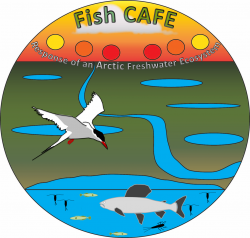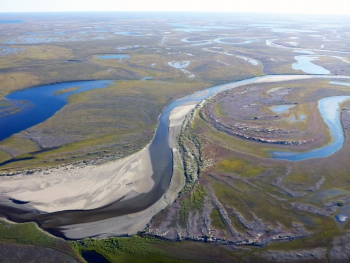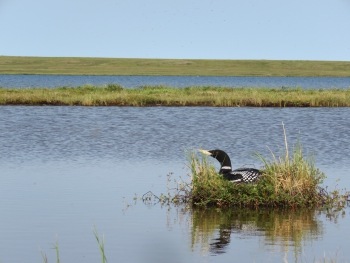By Chris Arp and Vladimir Alexeev, University of Alaska Fairbanks; Benjamin Jones, U.S. Geological Survey; Matthew Whitman, Stacey Fritz, Deb Nigro, Bureau of Land Management; Hannah Uher-Koch, University of Alaska Anchorage; and Ronnie Daanen, Alaska Department of Natural Resources

Adaptive management is an iterative process of science and management used to make decisions in the face of uncertainty. Recognizing the need to address habitat and species' responses to climate change through interdisciplinary science (IDS), in 2012 the Arctic Landscape Conservation Cooperative (ALCC) provided support to bring teams of scientists together to develop research to address these questions in focal watersheds of Arctic Alaska. The Fish CAFE (Response of an Arctic Freshwater Ecosystems to Climate and Land-use Change in the Fish Creek Watershed) team coalesced from this call to IDS action with disciplines including geography, anthropology, biology, hydrology, and climatology. The ALCC's Science Coordinator, Philip Martin, fostered a strategic "bottom-up" approach to the study design and collaboration among scientists from academia and resource management agencies, which was instrumental in making the IDS process work for Fish CAFE.
The 5,000 km2 Fish Creek Watershed is located in the northeast portion of the National Petroleum Reserve in Alaska (NPR-A) and is being strongly affected by both climate and land-use change. New oil development, expanding oil exploration, and rapid responses in permafrost, lakes, and streams due to climate change make mitigating impacts to habitat increasingly challenging. The rate and magnitude of land-use and climate change affecting this hydrologic unit is still highly uncertain, yet is of deep concern to many stakeholders, including Indigenous residents who rely on its lands and waters for subsistence resources.
Past research and long-term environmental monitoring programs in the NPR-A allowed the Fish CAFE team to take an adaptive management approach to address uncertainty in species and habitat responses to environmental change. The first need identified by our IDS team was to classify the dominant aquatic habitat of this watershed to guide other research components. This involved development of a new lake-based classification system for the Fish Creek Watershed based on input from the Fish CAFE team. More targeted field studies of fish communities, Yellow-billed Loons, and their supporting foodwebs applied this new habitat classification in their research design.

Now, coupling hydrologic studies of stream-lake connectivity with the lake-based classification and process studies of lake water balance allows more selective regulation of winter water use for ice road construction. Analyses of climate scenarios are increasing knowledge of how sea ice extent can impact regional winter water supply. Hydrologic modeling scenarios of water-extraction over a range of drought to deluge conditions are informing habitat management in key catchments where new oil development is occurring. Loon nesting habitat studies across the watershed are also being linked to hydrologic connectivity and water balance through the lake-based classification and watershed-scale modeling. More focused loon behavioral studies are informing buffer distances to mitigate human disturbance as development progresses towards lakes used for nesting.

These and other Fish CAFE science outcomes are part of an ongoing adaptive management process that is essential to sound decision making in the NPR-A and can serve as a model for other Arctic regions facing climate and land-use uncertainty. A prime example is the even more dynamic and lake-rich coastal lowlands surrounding Teshekpuk Lake, where potentially large oil reservoirs are currently off limits due to important caribou-calving and goose-molting habitats. The recent opening of the Arctic National Wildlife Refuge to oil and gas development will require using adaptive management strategies to balance winter water supply with aquatic habitat protection and to address diverse stakeholder concerns for this region.
More information on this project and region is available on the Fish Creek Watershed Observatory website.
For questions about this project, please contact Chris Arp (cdarp [at] alaska.edu).
About the Authors
 Chris Arp is a Hydrologist with the Water and Environmental Research Center at the University of Alaska Fairbanks.
Chris Arp is a Hydrologist with the Water and Environmental Research Center at the University of Alaska Fairbanks.
 Vladimir Alexeev is a Climatologist with the International Arctic Research Center at the University of Alaska Fairbanks.
Vladimir Alexeev is a Climatologist with the International Arctic Research Center at the University of Alaska Fairbanks.
 Benjamin Jones is a Geographer with the Alaska Science Center, U.S. Geological Survey in Anchorage
Benjamin Jones is a Geographer with the Alaska Science Center, U.S. Geological Survey in Anchorage
 Matthew Whitman is a Biologist with the Arctic District Office, Bureau of Land Management in Fairbanks
Matthew Whitman is a Biologist with the Arctic District Office, Bureau of Land Management in Fairbanks
 Stacey Fritz is an Anthropologist with the Arctic District Office, Bureau of Land Management in Fairbanks.
Stacey Fritz is an Anthropologist with the Arctic District Office, Bureau of Land Management in Fairbanks.
 Debbie Nigro is a Biologist with the Arctic District Office, Bureau of Land Management in Fairbanks.
Debbie Nigro is a Biologist with the Arctic District Office, Bureau of Land Management in Fairbanks.
 Hannah Uher-Koch is a Biologist with the Department of Geography and Environmental Studies, University of Alaska Anchorage.
Hannah Uher-Koch is a Biologist with the Department of Geography and Environmental Studies, University of Alaska Anchorage.
 Ronnie Daanen is a Geologist with the Division of Geological and Geophysical Surveys, Alaska Department of Natural Resources in Fairbanks.
Ronnie Daanen is a Geologist with the Division of Geological and Geophysical Surveys, Alaska Department of Natural Resources in Fairbanks.
